When I started writing this article, I realized that these are my favorite art potters, but really this article should have been titled, My Grandmother’s Favorite Art Potters. These are her top three by far! Isn’t it amazing what we learn from our elders? But I never looked at my grandmother as an elder, more like an amazing friend and mentor. I miss her a lot and so does the rest of my family. I hope that I can make that same impact on my kids and hopefully grandkids. Carpe Diem.
So lets get back on track and learn about my grandmother’s three favorite art potters!
Moorcraft
My grandmother always loved Moorcroft pottery. It was not easy to find and she only ever had two pieces. One was this small pitcher or cruet that she had bought in England.
Sometimes on rainy days we would take a break from pricing and she would show me her collections. She was telling me about this Moorcroft piece on one such day and I told her how beautiful I thought it was. She said, “You like it, it’s yours.” “Grandma, you give me far too many things.” “No, I want you to have it,” she said. “Don’t say another word.” She got one of the little scrap cards that were always around and wrote “Property of Lynn Dralle” and taped it to the base. We usually left the things that she gave us in her home in her cupboards so that she could still enjoy them. But we knew that they were now ours.

When my grandmother started in the antiques business in the 1940s, there weren’t a lot of written materials available to help dealers learn about their wares. Antiques reference guides were few and far between. One of the ways my grandmother acquired some of her knowledge was by reading antiques magazines like Hobbies and Antiques Dealer. One of her favorites in later years was the Antique Trader. We bought and sold many things through this great publication. She would cut out any pertinent advertisements or articles and place them inside the items they referred to. This Moorcroft pitcher had one of those little scraps of paper tucked inside. It was a clipping from the Antique Trader in 1990 which listed a Moorcroft vase for sale for $1,010, so we knew the pitcher was a good piece.

Moorcroft was originally founded in 1897 in England as a studio within a larger company, Macintyre Potteries. The designer was 24-yearold William Moorcroft, who soon began to sign or initial each piece of pottery he produced. This did little for the Macintyre company, and in 1912 William Moorcroft went out on his own. He began making his most popular “Pomegranate” ware around 1914. Queen Mary collected his pottery, and in 1928 he was named “Potter to the Queen.” He passed away in 1945 and control of the company went to his son, Walter. The company is still in business and their pottery is fabulous.
I decided to sell this piece and found that it had the script signature of the actual William Moorcroft! The other piece my grandmother had was just signed with a stamped signature. I knew this made it a great piece and I put it on with a $499 reserve. It sold for $1,092 and went back to Great Britain. We got more than she had thought it was worth in 1990. She would have been happy!

Mideke
Several years ago I sold a Mideke coffee mug that I found at a Goodwill in Cathedral City for almost $50, When My mom saw that, she decided to sell some of her Mideke pieces. Here is one of those pieces. A lovely bowl that I remember being in our house when I was growing up.
This sold for a lot of money.
With all these Mideke pieces being talked about, I decided that it would be a great time to do an article about Louis Mideke and his wife Jean, who was also a potter.
I grew up hearing about Mideke and what a fan of his work was my grandmother! She often bought pieces from his studio. They were friends and both had their businesses located off of Sunset Drive in Bellingham, Washington. I don’t think I ever met Louis but from what I have read about him, he was quite the character…just like my Grandmother!
I had moved back to Bellingham in 1993 to run my grandmother’s shop and one day in 1994 we got a phone call from Robin Reynolds, owner of The Good Earth Pottery in the Fairhaven area of Bellingham. Louis Mideke had passed away in 1989 and Jean in 1993. When the estate was closed in 1993, hundreds of pieces were found throughout the attic, house and grounds. A small selection was reserved for museum donations and the larger selection was purchased by Robin and sold at the Good Earth Pottery. After about a year of handling the pieces, Robin wanted to sell the entire collection.
Off went my Grandmother and I to see Robin. We ended up buying what remained, about 200 pieces. There was nothing that made my Grandmother happier than spending money–on stock for the store! As we packed up box after box, Robin mentioned that she had put together a packet of articles about Louis and Jean and that she had worked on it with Louis’s son Michael. Robin gave us this packet to hand out to anyone that purchased the Mideke pieces now located at Cheryl Leaf Antiques.
Line sketch of Louis Mideke done in 1958
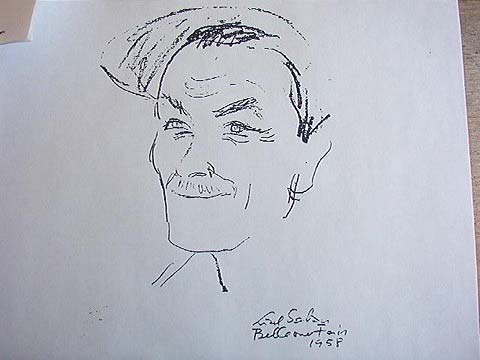
When I decided to write this article, I searched all over my office for those papers. Couldn’t find them anywhere. How was I going to write this one? I got on Google, but couldn’t find much of anything about the Midekes. I decided to start cleaning my office–about time anyway—and there on a shelf was the pile of articles!!! Yippeeee!!!
I immediately tracked down Robin Reynolds who now lives in North Dakota and asked her permission to share all this wonderful information with you and she said, “Of course!” She said that we should also credit Michael Mideke with helping to draft the articles and the timeline. Robin is a very talented artist and now works with the clays in North Dakota. Check out her amazing web site here NDClay.com.
So here we go….Courtesy of Robin Reynolds and Michael Mideke
This first section was written by Robin Reynolds in 1993:
Jean Mideke 1911-1993
Louis Mideke 1908-1989
Many Whatcom County residents knew Jean and Louis Mideke as an extraordinary couple who made many valuable contributions to the art and life of our community. In 1981 Louis was honored as a “living treasure” by the Municipal Arts Commission in Bellingham, Washington as a potter whose work was characterized by his use of local materials; distinctive, utilitarian, and elegant.
Jean Mideke’s early work sculpting clay and jewelry fabrication culminated in a later period of lost-wax bronze birds and jewelry of exceptional quality. Perhaps less productive than Louis, Jean “subsidized” the pottery until her retirement from teaching in the mid-1960s. “Although Jean and Louis worked independently,” says their son, Michael, “they almost always worked cooperatively, constantly providing each other with critical and technical support.” The Midekes closed their Sunset Drive showroom in 1985 and announced the pottery was sold out.
I was an apprentice potter when I met the Midekes in 1980, not long before the eruption of Mt. St. Helens. The following years of “shop-talk”, exchange of St. Helens glaze formulas, and socializing seem balanced in my favor as I recall the combined effect of the Mideke’s sharp humor, opinions, and philosophic gems. Their generosity stands in contrast to Louie’s (as everyone called him) reputation for crustiness. In her Living Treasure Tribute speech, former Arts Commissioner, Marian Boylan related, “Louis is like a good loaf of sourdough bread; crusty on top and soft as a marshmallow inside….leavened by many years of hard work and mellowed by the gentleness of his temperament and soul.” Perhaps he was not unlike what he found true in pottery; that a round pot has many sides.
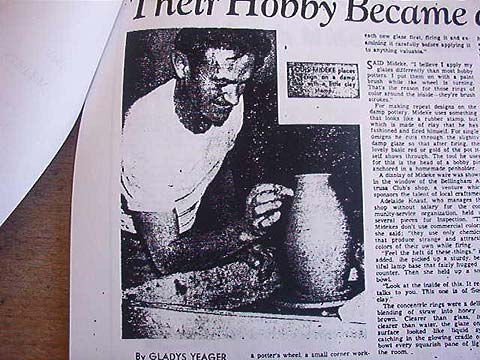
“Early in his career,” according to Michael Mideke, “Louis entered pieces in shows and won some honors, but this aspect of the “Art” business did not appeal to him. He felt pottery should be useful, beautiful to see and touch, and accessible to the people. As in everything he did, Louis was a self-educated potter. He gathered his inspiration from books and museums, grounding himself in a tradition that was predominantly oriental.”
Louis used local materials as both clay bodies and glaze ingredients for endless experimentation and record keeping. He also believed his pottery ought to be smooth enough to sit on the finest mahogany surface without scratching, according to his former student and friend, Bob Jeffcott, who also said Lou believed one pot in a thousand was museum quality.
Once he got started, pottery dominated the rest of Louis’ working life. But he was never exclusively a potter, since he continued to work in metal and wood. Louis’ health became increasingly fragile from the mid-1970s and during the 1980s arthritis began to hamper his wheel work. Eventually this, in conjunction with the demands of firing, became more than he could manage and pottery production ceased.
Perhaps understanding the Mideke legacy is better navigated in an answer given by Shoji Hamada, world-renowned potter, when he was asked how he felt when one of his pots was accidentally broken or otherwise lost. He replied, “What is important is not how you feel when you have or see the pot, it is in what remains when the pot is gone.”
1993 Robin Reynolds www.ndclay.com
Robin and I discussed Louis’ signatures and we think that the one with the tree was one of the earliest. Sorry, I don’t have a photo. Also remember that he didn’t always sign his wood or metal pieces.
Then came the MIDEKE block stamp as shown here on the base of my favorite Mideke vase.
Cross vase and signature.
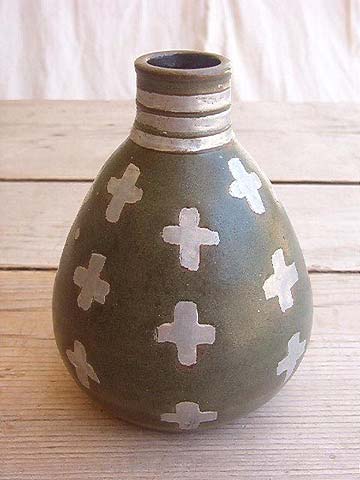
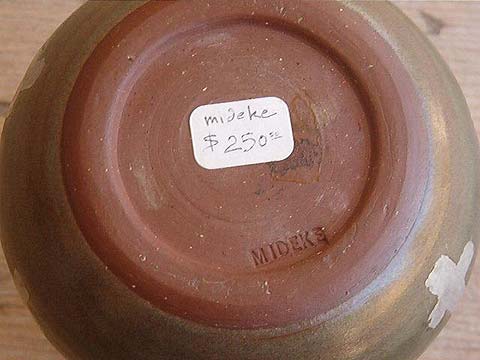
Then came the Mideke script signature as shown here.
His real autograph!

Chronological Notes–Robin Reynolds and Michael Mideke
Louis Mideke
1908 Born in Grandview, Washington to a farming family.
1923-1940 Keeps a diary, honing his skills as a writer. Photography another active pursuit in Washington and later in Alaska. The surviving snapshots reveal a sensitive eye and a solid sense of design.
Circa 1927 Comes to Bellingham. Meets the Hibners. Works Northwest jobs: mills, fields, sheep ranches, steamers and forest fire fighting. Dreamed of Alaska and announced a determination to be his own man.
1929-1930 Heads North. Later to call these his “energetic years.” Homesteads in SW Alaska, a year on Glacier Bay, runs the length of the Yukon River in a rowboat, works for the Lammers Exploration Company, and dredges gold around the Arctic Circle. Comes south winters and gravitates to Bellingham and his ten year correspondence and courtship of Jean Hibner.
1938 Marries Jean Hibner.
1938-1940 They go north. Jean working as cook for a small mining camp where Louis was foreman.
WWII Bremerton, WA. Works as a shipbuilder; instructor-welder.
1943 Son, Michael, born.
1947 Family moves to Bellingham. Louis was still off on occasional expeditions with Lammers, but they grew shorter and more local–Wyoming, Idaho, California and British Colombia.
1948 Buys the Sunset Drive property. Louis immediately sets to work improving the place and putting in a garden. But “work” was no fun and money scarce, and in the evenings he whittled whimsical things by the fireplace.
1950 Gets his hands in clay and once he got started, pottery dominated the rest of Louis’ working life. His work in metal and wood continues, and from time to time his excursions into metal left the wheel briefly idle. First studio in the laundry room.
My metal mideke lamp.
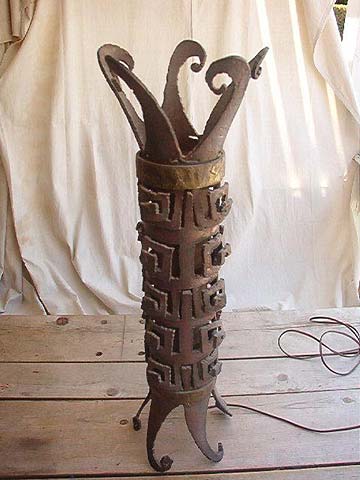
1951 Wins the L.T. Butler award for excellence at the Northwest Craftsmen’s Show in Portland Oregon.
Peter Volkous invites him to work in Montana at the Archie Bray Foundation, but unthinkable for the solitary worker to join the “Wildman” at the Bray scene.
Beginning with commercial clays, he quickly shifted to local clays…from natural inclination and to save money. This step dictated the development of locally based glazes.
1953 Converts an elderly chicken house into a studio. Fires wares in a small electric kiln.
1954 Sales shop open for business.
Wins Clay Purchase Award, Henry Gallery, University of Washington, Seattle. Northwest Craftsmen’s Exhibition.
Continues to work with local materials. Midrange electric firing vitrified clay bodies.
1964 Meets Bob Jeffcott and uses trapline clay from Jeffcott’s tile plant near Everson, WA.
1965 High fire, reduction kiln (gas) installed at Jeffcott’s allowing him to work in porcelain and stoneware. Although commercial clay bodies, local materials continued to play a significant role in his work. Commercial bodies allowed him more time making pots than he’d previously spent processing local clays.
1967 Moved kiln to the backyard at Sunset Drive.
Mid 1970s His health increasingly fragile.
1974 Retrospective show at the Whatcom Museum of History and Art in Bellingham, WA.
1981 Designated a “living treasure” by the Municipal Arts Commission, Bellingham, WA.
Arthritis hampers his wheel work.
1985 Business at Sunset Drive closes in March
1989 Dies, survived by wife, Jean, son, and two grandchildren.
1993 Jean dies, survived by her son, one sister, and two grandchildren.
Here is another piece of Mideke that my mom
sold on eBay.
This next interesting quote comes from an article written by Mary Kay Becker for “Northwest Passage” in November of 1971….
“Though his work has been exhibited and sold from coast to coast, you might live a long time in Whatcom County without knowing of him. “I don’t beat a very big drum,” he told us. A small sign almost hidden by shrubbery marks the location of his home and backyard workshop (open Wednesday thru Saturdays) at 1906 E. Sunset Drive. Visitors interested in high quality pottery can there observe the process as well as the product.
Hanging on the wall as you go in is a handmade poster, sent to Mideke by a “fancier” in Greenwich Village and inscribed with a quotation from Hawthorn: “Men are earthen jugs with spirits in them.” Here, in the front of the shop, the finished pots are for sale ŌĆō a few shelves of pitchers, bowls, cups and jugs. In back is the work area where squarish lumps of grey Washington clay the unfired beginnings of the pots emerge whirling and wet. Under the guidance of Mideke’s hands and tools, necks are narrowed, lips flare out, and eccentric contours are smoothed into symmetry. Fingers as well as eyes find a feast here.
Mideke’s setup includes three wheels, a large and a small kiln, and row upon row of glass jars containing the materials from which he compounds his own glazes, experimenting frequently find new effects. An old favorite is the crackle pattern produced by shrinking of the glaze around the pot during firing, the basics techniques for which were perfected by the Chinese a thousand years ago……
His own total production he estimates in the neighborhood of 100,000 ŌĆō”more than there’s room for in Whatcom County, I guess”. Outlets in Seattle and Berkeley have spread his pottery far and wide. Some he has seen reappear in second-hand stores, and once his signature was found on some shards of pottery that washed up on the beach.”
Wouldn’t Louis Mideke be surprised at how well his pottery is still selling and that it is being traded worldwide (mostly due to eBay)!
I really hope my sister’s pieces of Mideke sell for a small fortune. Here is a link to what she has for sale on eBay today.
Rookwood
Back in 2009 I was at an estate sale. I had bought a few things and was getting ready to leave when I spotted a beautiful vase in the garage. It obviously had lived a pretty hard life and had held a lot of flowers over the years, but there was just something about it that drew me closer.
Here is a close up of the vase.

My grandmother always said you can tell quality and this was quality. Cheryl Leaf also used to say, “If it was a quality piece when it was made, it will be a quality piece 100 years from now.” My grandmother only collected quality items and when I saw this vase, I just knew it could have been something I would have seen in one of her cabinets growing up.
I turned over the vase (which was marked $5) and couldn’t believe it when I saw the Rookwood signature.┬ĀI immediately got goosebumps.
Here is a picture of that signature.

The Rookwood Pottery signature is a Backwards R attached to a P–called their monogram signature. You can date a piece of Rookwood by looking at the candle flames above the signature and also looking for a roman numeral incised into the base.
The monogram signature was first used in 1886 (but remember the company was founded in 1880), and a flame was added around the symbol every year after until 14 flames were there and it was 1900. From 1900 on, the year was incised in the base in Roman numerals. I could tell from my signature that because there were 14 flames and a roman numeral IX (nine) that this piece was from 1909. Wow! As I write this article, that vase is exactly 100 years old!
I think my Grandma is helping me out with my writer’s block this week for many reasons. The first reason is her saying that “a quality item is quality when made and will still be quality 100 years from now!” And the fact that Rookwood was started and owned by a woman named Maria Longworth Nichols. Maria began the business in an old schoolhouse that her father bought for her and she named it Rookwood after her family’s country estate.
Maria was one of the high society women in Cincinnati, Ohio who in the late 1800s painted china blanks as a hobby. Rookwood started out as a sanctuary in 1880 for talented artistic women but soon turned into a well respected business. Rookwood was one of the first companies in America to be owned and operated by a woman. My grandmother was also a pioneer like Maria and was one of the first women to own and operate her own antiques store back in 1950.
After 1914, Rookwood began marking their pieces with the color or type of clay. Examples: P stood for soft porcelain, S for a special piece, Z for a matte glaze and a V for Vellum glazes. A trial piece was marked with a T and seconds were marked with an X. My piece was earlier than 1914, so did not have any of these marks.
Shape numbers and size letters were also used over the years. The style number of my vase was 952 and the Size was an E. The Sizes ranged from A being the largest to F being the smallest, so my vase was the second to the smallest size in this cylindrical shape.
Artist’s ciphers (or signatures) were found on the best pieces and the cipher on mine appeared to be a CE. Could it possibly stand for Cheryl Eldonna (my grandmother’s first and middle names)? Couldn’t name any of my kids that middle name–that is for sure!
Anyway, the CE that I could make out turned out to really be a CS that stood for Caroline Frances Steinle (Carrie). She was one of Rookwood’s famous artists (although it started out with just women, many men were eventually employed by the company). The famous Rookwood artists would sign their pieces differently. Some incised on the base like Carrie, and other signed with their initials within the pattern on the side of the piece.
Pretty fascinating isn’t it?
I knew that my grandmother had only ever been able to buy two pieces of Rookwood in her 50 years of being in the business and that those two pieces stayed in her private collection. (Strange but just like Moorcroft…only two pieces) and I have already found one of each maker…I may beat her record.
My grandmother loved quality and apparently so do I.┬Ā I also knew that Rookwood pieces in perfect condition could sell in the $1,000 range. As you can see from this close up shot, my vase had definitely been used to hold flowers and from the earlier photo–it had quite a bit of crazing. I knew this vase wasn’t going to sell in the $1,000 range.

I did my research but didn’t feel comfortable listing it without knowing more. I decided to pay for an online appraisal. There are many companies offering these now and I think they are a really neat idea. I took my photos, did my write up and sent off the info with my $11.95 Paypal payment. Then I sat around and twiddled my thumbs. Just kidding, I got back to listing other stuff on eBay but I have to admit, I couldn’t wait to see what the appraiser had to say.
The appraisal came by email the next day. I had already figured out most of it and it didn’t really tell me anything else about the piece. What I was really paying for was the valuation. I wanted to know what I should start this auction at and if I should use a reserve.
I was a little disappointed when the appraisal came in with the value at $100 IF IN PERFECT condition. Well, I didn’t agree and that is why I wrote this article—you have to trust your gut reaction. I went with my instinct and started the auction at $99.00. I think you will all be very surprised to see what it ended up selling for.

Score! Sold for $305.00!
I still value the $12 I spent on the appraisal because it did help me establish a starting price and it made me feel confident that anything I got over the $99 starting bid price was gravy. I got quite a bit of gravy from this vase!!!
Also, the appraiser was very nice, and said that she, “would love to go shopping with me.” I bet she would! And those of you who are attending Live eBay Boot Camp this year (yes it is 2011!) will get that chance to go shopping with me. Can’t wait!
The appraiser also said that the pottery works is now the Rookwood Pottery Restaurant. We both agreed that this is a very sad ending to one of America’s top makers of fine quality art pottery.
You see once Maria Longworth Nichols married (she became Mrs. Bellamy Storer, Jr) she lost interest in the business. Fortunately, she had hired a very talented manager, William Watts Taylor in 1883 and he was responsible for Rookwood being sold in stores like Tiffany and other fine department stores. While many of the pieces were done by famous artists like my Carrie Steinle vase, Rookwood eventually employed 225 workers that made production pieces. These are not typically worth as much as one with a well known artist’s signature.
Rookwood also became very famous for their architectural tile. The Great Depression (less discretionary income) is what really brought down the company and in 1941 they filed for bankruptcy. Many people tried to save the company, but Rookwood closed their doors in 1960. The original molds were purchased by a Michigan dentist in 1983.
Even though Rookwood is no longer in business, just like my grandmother’s antique store, the legacy of both women lives on.
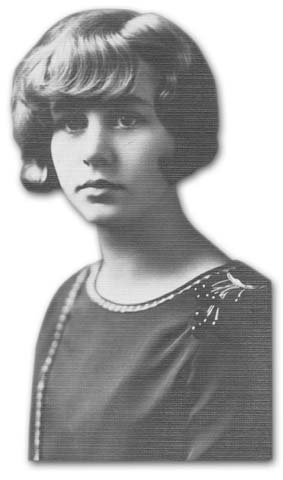
My Grandma
I hope that you find a piece of Rookwood pottery in your treasure hunting!
I know that by putting this article out there, some of you are going to come across pieces by these and other amazing companies. I can’t wait to hear your art pottery scores! Don’t overlook antique pottery, even with crazing. When you see well-done art pottery, you get a feeling that it was made by a master. Follow your instincts!
Happy eBaying!
Lynn
Visit my eBay Store.
Visit my eBay auctions.
For more great eBay tips and stories, visit my web site at:
http://www.thequeenofauctions.com
WANT TO USE THIS ARTICLE IN YOUR EZINE OR ON YOUR WEBSITE? Yes, you may – just as long as you include all links as they are and append this complete blurb with it: The Queen of Auctions and eBay Power Seller, Lynn Dralle, publishes ‘eBay Tips & Tricks’ a weekly ezine with 10,000+ subscribers. If you’re ready to jump start your eBay business, make more money and have more time, get your FREE tips now at www.thequeenofauctions.com




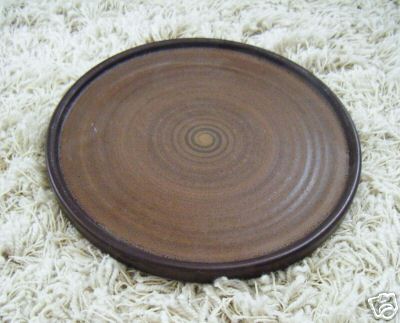

{ 3 comments… read them below or add one }
Hello. Great blog! Thank you for all this great information on Mideke pottery. I recently bought a pretty little Mideke vase, but the signature seems a bit unusual: it appears to have both the block-style name stamp, but above that also a tree with the letter “M” inside it. In your post you state that signatures with “the tree was one of the earliest”, and the black-style mark came latter. So perhaps mine is in between? Any thoughts? (I’m happy to share photos if you contact me directly.)
Many thanks!
At last! Something clear I can unnrdstade. Thanks!
I have a small vase with Mideke stamped in, and a tree above the name with a M in the middle of the tree, would like to know when it was made thanks.